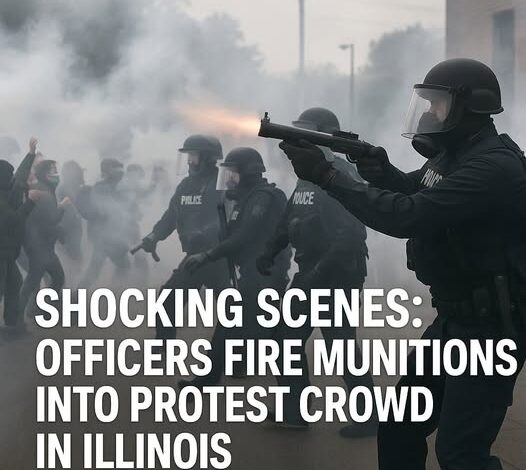TENSIONS BOIL OVER, Officers Fire Munitions Into Protest Crowd in Illinois!

Broadview, Illinois, was thrown into turmoil late Sunday night when a protest outside the U.S. Immigration and Customs Enforcement (ICE) processing center erupted into a violent confrontation between demonstrators and police. What began as a peaceful rally against deportations quickly spiraled into one of the most intense clashes the area has seen in recent years, leaving behind a shaken community and calls for accountability.
The gathering started with chants, signs, and speeches as families, clergy members, students, and longtime activists rallied to oppose federal immigration policies they believe tear families apart and unfairly target vulnerable communities. Witnesses described the early evening atmosphere as tense but orderly, with demonstrators remaining on sidewalks and grassy areas near the facility.
As darkness fell, the mood shifted dramatically. Police in full riot gear formed tight lines around the ICE facility, instructing protesters to stay off private property. Organizers claim the crowd complied with those orders, but tensions escalated when officers suddenly advanced. Within minutes, tear gas canisters were fired, filling the air with thick clouds of chemicals and sending people running for safety.
Videos shared on social media showed protesters coughing, pouring water over their faces, and using scarves and shirts to shield themselves from the gas. The situation worsened when officers deployed “less-lethal” crowd-control rounds directly into the crowd. The loud cracks of the munitions rang out over chants and screams, causing panic as people scattered. Several protesters were knocked to the ground, some suffering serious injuries that required immediate medical care.
“I saw a young man get hit in the leg by a projectile and just collapse,” recalled Claudia Reyes, a 29-year-old teacher who attended the protest with her sister. “He couldn’t walk. Others had to carry him out while the gas was still everywhere. It was terrifying.”
By night’s end, multiple arrests had been made, though authorities did not release an official count. Those detained were loaded into police vans while fellow demonstrators shouted their names and birthdates to ensure legal teams could track them. Paramedics confirmed they treated individuals for tear gas exposure and blunt-force injuries.
Local police officials defended their actions at a press briefing, claiming some protesters had attempted to breach the ICE center’s gates and had thrown objects at officers. They said tear gas and impact rounds were necessary to “restore order and protect public safety.” When pressed for evidence, the department said video footage would be released at a later time.
Protest organizers rejected that account, calling the response an extreme overreach.
“This was a peaceful demonstration until police decided to treat it like a battlefield,” said Miguel Castillo, director of Safe Haven Illinois, an immigrant rights group. “There were families with kids, clergy members, and teenagers—all forced to run for their lives because their voices were seen as a threat.”
Community leaders are demanding an independent investigation into the incident, arguing that the deployment of tear gas and kinetic rounds against unarmed demonstrators cannot become standard practice. Several suburban officials said they would urge state leaders to step in. Reverend Sheila Porter of the Southside Interfaith Coalition described the events as “a stain on Illinois” and urged both ICE and local law enforcement to face consequences.
The Broadview ICE center has long been a focal point of immigration activism. It serves as one of the final stops for immigrants facing deportation before they are transported out of the country. Every Friday morning, advocates and clergy members gather outside the facility for vigils to support families saying their final goodbyes. While emotional, these gatherings have rarely turned violent—until now.
Sunday night’s confrontation has drawn attention from state and national leaders. Representative Jan Schakowsky called the scenes “deeply disturbing” and urged the Department of Justice to conduct a review. Meanwhile, conservative voices praised law enforcement for preventing what they described as a potential breach of a federal facility.
The clash has reignited debate about policing at protests, especially those involving immigration issues. Critics argue that law enforcement agencies too often view immigrant communities and their allies as adversaries rather than citizens exercising their constitutional rights. Supporters of the crackdown counter that officers face volatile situations and must act quickly to maintain control.
Social media footage of officers firing munitions at retreating demonstrators has spread widely, sparking outrage beyond Illinois. Activists say the videos confirm their allegations of excessive force. Police officials, however, insist the clips lack context and warn against drawing conclusions from incomplete footage.
For those who were present, the events left a lasting impression.
“I went there to hold a candle and pray,” said Maria Torres, a grandmother from Cicero who has attended vigils outside the Broadview facility for over a decade. “Instead, I was choking on gas and running from rubber bullets. That’s not the country I believe in.”
Legal organizations have pledged to represent injured protesters pro bono, and lawsuits are expected in the coming weeks. Calls for the resignation of local officials are also growing louder. Activist groups are planning additional demonstrations—not only against ICE policies but also against what they describe as a broader effort to silence dissent through intimidation.
For now, Broadview remains tense. The ICE center, already a powerful symbol of federal immigration enforcement, has become the center of a larger struggle over civil liberties, policing tactics, and the right to protest. Whether authorities double down on their defense of Sunday night’s actions or bow to mounting public pressure for reform remains to be seen.
What’s certain is that the night left deep scars—physical for those injured, emotional for those who fled, and political for a community now reckoning with how far officials will go to maintain control when ordinary people demand change.